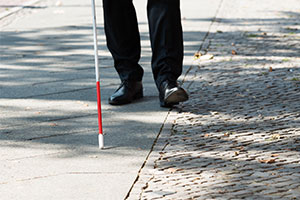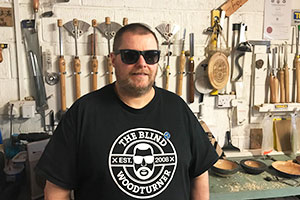How the eCane will change the lives of blind and deafblind users

Physicist Ron Liebermann formed Signtel, Inc. in 2000 with the mission to use technology to improve the lives of the hearing and sight challenged people. He hired over 100 such individuals to work as assistant developers, providing their own life experience as input into the products developed. Here, he explains how his product the Electronic Cane eCane will become the eyes and ears of people who are blind or deafblind… The eCane is a contraption mounted and attached to a cane used by blind individuals who are either only blind, or both blind and deaf (deafblind). Its uses are broadly twofold: Firstly, it provides secure navigation. The Electronic Cane guides its holder to a desired location by giving directive instructions towards such location. Secondly, the Electronic Cane acts as a communications tool, utilising mobile phone, sign language, foreign language translation and internet communications. Features of the eCane • The user can access a mobile phone using either voice and/or Morse Code via a button on the Electronic Cane. The user receives input by voice, or Morse Code through vibrations of the Electronic Cane • The user can find out on demand the locations and proximity of their family members (or designated friends), as the Electronic Cane operates with cooperating technologies, such as (RFID), GPS, or Google’s indoor navigation. This is made possible thanks to a contraption such as a wristband, belt or cloth worn by the friend or family member. • The Electronic Cane can navigate to desired locations when the user provides a request by voice or by clicking Morse Code on a button and receiving continuous directions for movements, either by voice or via the eCane vibrating in Morse Code. This makes it easy for the user to find their home, a hotel, office, business facility or store etc. As an example, if a blind individual requests the eCane to be led to a bathroom while in a hotel lobby or supermarket, the eCane will direct that person to the bathroom that is for the correct gender of the blind individual. • Navigation also works within the user’s home around various rooms, features and furniture. Outdoors the eCane guides across roads, up and down pavements, advised by the eCane what store is encountered and what is displayed in the window. Once inside a store, navigation is given, allowing the user to pick up desired articles from the shelf. • The eCane holder is advised about the environment around him or her, such as “a woman walking a small dog is coming towards you and a child who is riding his scooter just past next to you”. This is enabled by a video camera being attached to the eCane system and artificial intelligence analyzing the images. • Enabling the eCane holder to perform monetary transactions, such as payments or receiving money, which is done directly through the eCane holder’s bank account. • Communicating with deaf individuals, utilizing Sign Language, wherein Sign Language of the deaf is captured by the camera which is then translated to the eCane holder in audio and/or Morse Code vibrations. • Secure walking, whereas the eCane detects objects either on the ground or elevated, and warns the eCane holder of their proximity, height, being stationary or moving, as well as giving a description of their nature. • The eCane notifying its holder when the “battery” (mostly a Supercapacitor) needs a recharge, which is mostly done automatically by just being in proximity to the charging facility. • Ability of the eCane holder to find the eCane that was either, dropped, forgotten or placed in any location by pressing a knob on the wristband unit carried by the eCane user. • The wristband mentioned above can also provide various alerts to its deafblind holder, such as a phone call coming in, somebody talking, someone in your vicinity is communicating with you or an alarm clock to wake up the user. For more information about Signtel, see signtelinc.com. Signtel will be exhibiting at Naidex at the NEC on 17 & 18 March 2020, at stand N345.
How Chris kept on turning after going blind

Chris Fisher has made quite a name for himself in the media – you might know him as The Blind Woodturner. Chris wasn’t born blind – toxoplasmosis struck in 2008 when he was working as an engineer with a busy life as a husband and dad to a young son. But after a difficult adjustment period, where Chris had to battle severe anxiety as well as get used to life without sight, he “turned” his life around. With the help of wife Nicola, he is now helping others to do the same. UCan2 editor Victoria Galligan caught up with Chris at his home in Whittle-le-Woods, Lancashire… What happened when you went blind suddenly 12 years ago? How did you cope? You learn to adapt – I suffered with crippling anxiety for four years and that started about a year after going blind. The first year of being blind was all about going to rehab, working with a sensory team and social workers but then I started feeling terribly sick, actually being sick, having panic attacks, hallucinations, muscles spasms, not sleeping, being afraid to go out and sometimes having to come back home because I’d had a panic attack and support worker at the time, Dean, would have to bring me home. It was a terrible place to be. If I didn’t have the network of people around me, my friends and family, I probably would have ended my life. I get why people commit suicide and I was getting towards that point. Luckily I have a son, who was seven at the time, and a wife and I felt I didn’t have that option. So I dug deeper than I ever thought possible and, with the help of counselling from the RNIB’s bereavement service, and going on anti-anxiety meds, slowly but surely I felt “Hey! I actually felt good today!” Then I started going out more – I got through it and I’m so glad I did. Then I started chomping at the bit and feeling: “Right, I’m ready to attack life now!” You mentioned your PA Dean and the RNIB – which other services were there to help you? Initially it was support from Wigan Council’s Sensory Team as I lived in Greater Manchester at the time. They were absolutely brilliant in helping me to come to terms with my disability and giving me practical advice – they taught me how to prepare a simple meal safely or a cup of tea. They showed me how to use some gadgets like a signal cane, and I got some other gadgets from the RNIB like liquid level indicators, talking measuring jug, talking tape measure and a Daisy Player which is a device that plays CDs with tactile, chunky controls on it. I use it to listen to books. And for the first eight years I had a support worker, Dean, then when he changed his job I got Bamber, my guide dog. He’s next-level intelligent and truly indispensable. I’m the navigator when we go out but he’s my pilot and takes me where I need to go! I can ask him to find steps, find a button for a lift, a bus stop. At home, he never leaves me on my own and he’s always watching me! He comes down the stairs in front of me to make sure I’m safe and he’s ever-vigilant. How did the woodturning start? I started to want to try new things – but obviously as a blind man. And because I was a keen horror film fan and loved doing stuff at Halloween for the house. I wanted to make a vampire stake for the garden – people said “You what?” but it was something I wanted to do! You’ve got to start somewhere. I started to listen to woodturning tutorials on YouTube and ended up listening to 600 hours! I was really serious about it because I wanted that vampire stake! I listened for five or six hours a day for months, assimilating all the information I could about woodturning, tools, techniques, health and safety and finishing. I got in touch with a few YouTubers to ask them to add some audio description to the videos – a lot of the videos are compressed, with no verbal directions and they’re set to music, which is of no use to the blind! So about 10 woodturning YouTubers added some verbal information and they’d say: “This blind guy’s got in touch because he wants to learn woodturning so, for you Chris, I’m going to explain what I’m doing here!” After the 600 hours I got myself a lathe, some wood and some tools and taught myself, just by touch and with a picture in my mind. Because I was sighted until I was nearly 39 years old, I had a great memory map which played in my favour. I’d worked with tools and my hands all my working life – I didn’t have any accidents but my early work was a bit shoddy and I made mistakes. But I put the hours in and the practice and became very passionate and people started to want to buy what I was making. Last August I became the first-ever blind person to join the Register of Professional Turners. I had to apply with photos of my work. This had to be backed by two sponsors, and then they came out to assess me. It was a rigorous test by a master turner from the Worshipful Company of Turners (which has 800 years of history). There was an interview, an accounts check of my business to make sure I was making money from woodturning, a risk assessment check, an examination of my completed works plus a check of the workshop and a practical assessment – which was videoed. It was tough but I passed! You’ve now built a real brand around yourself! How did you achieve that? I started a YouTube channel to inspire and motivate people